不定式做宾补和后置定语的区别
- 格式:docx
- 大小:416.28 KB
- 文档页数:9
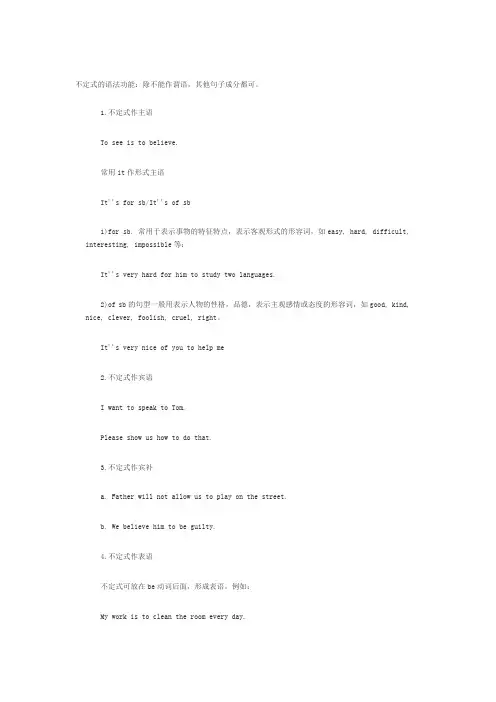
不定式的语法功能:除不能作谓语,其他句子成分都可。
1.不定式作主语To see is to believe.常用it作形式主语It''s for sb/It''s of sb1)for sb. 常用于表示事物的特征特点,表示客观形式的形容词,如easy, hard, difficult,interesting, impossible等:It''s very hard for him to study two languages.2)of sb的句型一般用表示人物的性格,品德,表示主观感情或态度的形容词,如good, kind,nice, clever, foolish, cruel, right。
It''s very nice of you to help me2.不定式作宾语I want to speak to Tom.Please show us how to do that.3.不定式作宾补a. Father will not allow us to play on the street.b. We believe him to be guilty.4.不定式作表语不定式可放在be动词后面,形成表语。
例如:My work is to clean the room every day.5.不定式作定语不定式做定语通常要放在被修饰的词后。
例如:I have a lot of work to do.6.不定式作状语1)目的状语to… ,only to (仅仅为了),in order to, so as to, so(such)… as to… (如此……以便……)He ran so fast as to catch the first bus.I come here only to say good-bye to you.2)结果状语What have I said to make you angry.He searched the room only to find nothing.3)原因状语I''m glad to see you.用作介词的toto 有两种用法:一为不定式+动词原形; 一为介词+名词/动名词, to 在下面的用法中是第二种,即to+ 名词/动名词:admit to承认,confess to承认,be accustomed to 习惯于,be used to 习惯于,stick to 坚持,turn to开始,着手于,devote oneself to 献身于,be devoted to 致力于, look forward to 盼望,pay attention to 注意省to 的动词不定式1) 情态动词 ( 除ought 外,ought to):2) 使役动词 let, have, make:3) 感官动词 see, watch, look at, notice , observe, hear, listen to, smell, feel, find 等后作宾补,省略to。
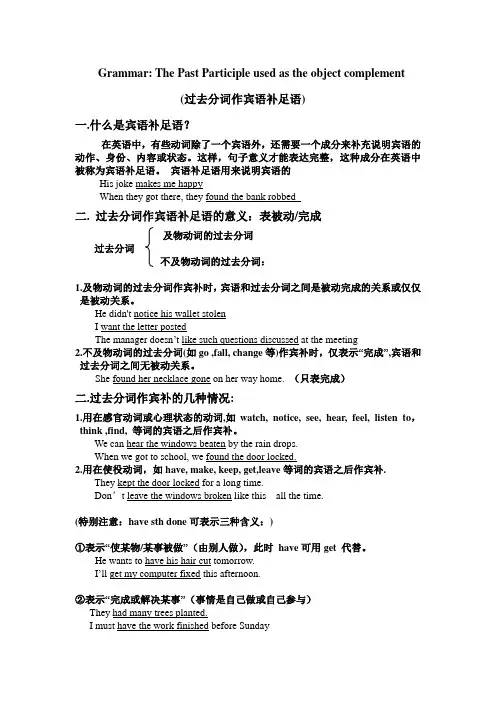
Grammar: The Past Participle used as the object complement(过去分词作宾语补足语)一.什么是宾语补足语?在英语中,有些动词除了一个宾语外,还需要一个成分来补充说明宾语的动作、身份、内容或状态。
这样,句子意义才能表达完整,这种成分在英语中被称为宾语补足语。
宾语补足语用来说明宾语的His joke makes me happyWhen they got there, they found the bank robbed二. 过去分词作宾语补足语的意义:表被动/完成及物动词的过去分词过去分词不及物动词的过去分词:1.及物动词的过去分词作宾补时,宾语和过去分词之间是被动完成的关系或仅仅是被动关系。
He didn't notice his wallet stolenI want the letter postedThe manager doesn’t like such questions discussed at the meeting2.不及物动词的过去分词(如go ,fall, change等)作宾补时,仅表示“完成”,宾语和过去分词之间无被动关系。
She found her necklace gone on her way home.(只表完成)二.过去分词作宾补的几种情况:1.用在感官动词或心理状态的动词,如watch, notice, see, hear, feel, listen to,think ,find, 等词的宾语之后作宾补。
We can hear the windows beaten by the rain drops.When we got to school, we found the door locked.2.用在使役动词,如have, make, keep, get,leave等词的宾语之后作宾补.They kept the door locked for a long time.Don’t leave the windows broken like this all the time.(特别注意:have sth done可表示三种含义:)①表示“使某物/某事被做”(由别人做),此时have可用get 代替。
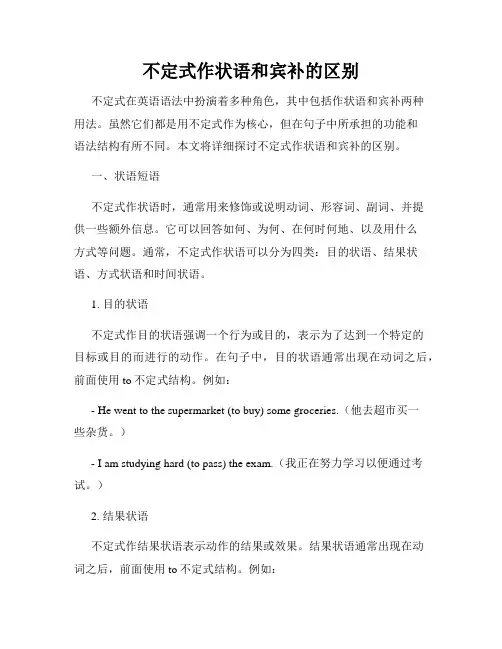
不定式作状语和宾补的区别不定式在英语语法中扮演着多种角色,其中包括作状语和宾补两种用法。
虽然它们都是用不定式作为核心,但在句子中所承担的功能和语法结构有所不同。
本文将详细探讨不定式作状语和宾补的区别。
一、状语短语不定式作状语时,通常用来修饰或说明动词、形容词、副词、并提供一些额外信息。
它可以回答如何、为何、在何时何地、以及用什么方式等问题。
通常,不定式作状语可以分为四类:目的状语、结果状语、方式状语和时间状语。
1. 目的状语不定式作目的状语强调一个行为或目的,表示为了达到一个特定的目标或目的而进行的动作。
在句子中,目的状语通常出现在动词之后,前面使用to不定式结构。
例如:- He went to the supermarket (to buy) some groceries.(他去超市买一些杂货。
)- I am studying hard (to pass) the exam.(我正在努力学习以便通过考试。
)2. 结果状语不定式作结果状语表示动作的结果或效果。
结果状语通常出现在动词之后,前面使用to不定式结构。
例如:- She ran fast (to catch) the bus.(她跑得很快,以便赶上公共汽车。
)- They work hard (to achieve) success.(他们努力工作以取得成功。
)3. 方式状语不定式作方式状语表示动作发生的方式或方式,它回答了“如何”的问题。
方式状语通常出现在动词之后,前面使用to不定式结构。
例如:- They communicated clearly (to avoid) misunderstandings.(为了避免误解,他们进行了明确的沟通。
)- He walked slowly (to show) his tiredness.(他慢吞吞地走着,表达出他的疲倦。
)4. 时间状语不定式作时间状语表示动作发生的时间或时间。
它回答了“何时”的问题。
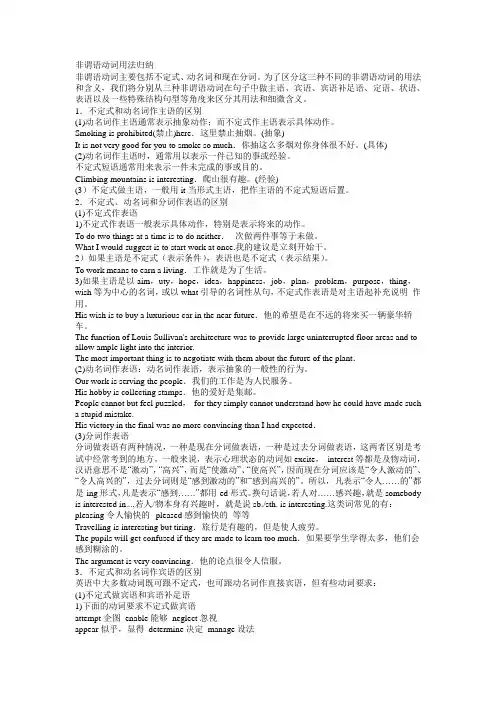
非谓语动词用法归纳非谓语动词主要包括不定式、动名词和现在分词。
为了区分这三种不同的非谓语动词的用法和含义,我们将分别从三种非谓语动词在句子中做主语、宾语、宾语补足语、定语、状语、表语以及一些特殊结构句型等角度来区分其用法和细微含义。
1.不定式和动名词作主语的区别(1)动名词作主语通常表示抽象动作;而不定式作主语表示具体动作。
Smoking is prohibited(禁止)here.这里禁止抽烟。
(抽象)It is not very good for you to smoke so much.你抽这么多烟对你身体很不好。
(具体)(2)动名词作主语时,通常用以表示一件已知的事或经验。
不定式短语通常用来表示一件未完成的事或目的。
Climbing mountains is interesting.爬山很有趣。
(经验)(3)不定式做主语,一般用it当形式主语,把作主语的不定式短语后置。
2.不定式、动名词和分词作表语的区别(1)不定式作表语1)不定式作表语一般表示具体动作,特别是表示将来的动作。
To do two things at a time is to do neither.--次做两件事等于未做。
What I would suggest is to start work at once.我的建议是立刻开始干。
2)如果主语是不定式(表示条件),表语也是不定式(表示结果)。
To work means to earn a living.工作就是为了生活。
3)如果主语是以aim,uty,hope,idea,happiness,job,plan,problem,purpose,thing,wish等为中心的名词,或以what引导的名词性从句,不定式作表语是对主语起补充说明作用。
His wish is to buy a luxurious car in the near future.他的希望是在不远的将来买一辆豪华轿车。

不定式在句中用法广泛,可以充当除了谓语之外的任何成分。
但对不定式做定语,很多高中学生都比较陌生,所以下面就动词不定式todo做定语做一简要总结。
不定式在句中做定语通常做后置定语,即放在被修饰名词或代词后。
它通常有以下几种用法:(一)不定式常可用来修饰物,表示要做某事。
如:1.The next train to arrive was from NewYork.下一列到站的火车是从纽约开来的。
2.I have nothing to say on this question.在这个问题上,我没有什么话要说。
3. We are looking for somewhere to live.我们正在找一个地方住。
(二)不定式还可用来修饰人。
如:1.He was the first guest to arrive.他是第一个到达的客人。
2.Miss Brown was the next person to rise to speak.布朗小姐是下一个起来发言的人。
3.He was a brave man to do what he did.他是个勇者才有这样的行为。
(三)很多特定的名词后也可用不定式做定语,这样的名词常用的有:way,time,reason,chance,opportunity,need,wish,effort,right,ambition等。
如:1.It's time for you to get up and go to school.你该起床去上学了。
2.There is no reason to doubt his word.没有理由怀疑他的话。
3.They have now an opportunity to go abroad to study further.他们现在有机会出国深造。
(四)某些动词或形容词后可接不定式时,它相应的同根名词也常用不定式做定语。
如:1.He made an attempt to learn English well.他试图学好英语。

不定式作定语不定式作定语:本节有关知识点与不定式作宾语、宾补不同,不需要记住那么多特殊动词的特殊用法。
但它更强调理解。
而且在实际应用过程中,本节容易出错的地方更多。
这是学习者首先需要注意的。
要理解本节内容,就要注意分析不定式所修饰的名词与作定语的不定式关系5.1宾语关系5.1.1.四种表现形式:I have a letter to write.(动词宾语)He needs something to hope for(动词短语的宾语。
hope for 在意义上不可分割)I need a pen to write with。
(不定式中介词宾语write with在意义上分割)不能说write a pen,可以说write with a pen.其实是介词及其宾语在逻辑上一块作方式状语,来修饰不定式to write.再如:I have no language partner to practice speaking English with.句子的本意不是说language partner自己practice speaking English,而是我practice speaking English,需要有language partner伴随。
因此句后加了一个with,与language partner一块作逻辑意义上的伴随状语,修饰practice speaking English。
I need some paper to write on.(不定式中介词宾语write on在意义上分割)分析类似上,其实是介词及其宾语在逻辑上一块作地点状语,来修饰不定式to write.再来分析为什么下例为何错误:She has some children to take care of them.动词词组To take care of与children已经构成了逻辑上的动宾关系,与前面的例句“I have a letter to write.”意义相同,还要them 干嘛?综上所述,不定式作定语时,要时刻注意不定式与所修饰的名词的逻辑语义关系,时刻注意不定式动词后面是否需要加介词。
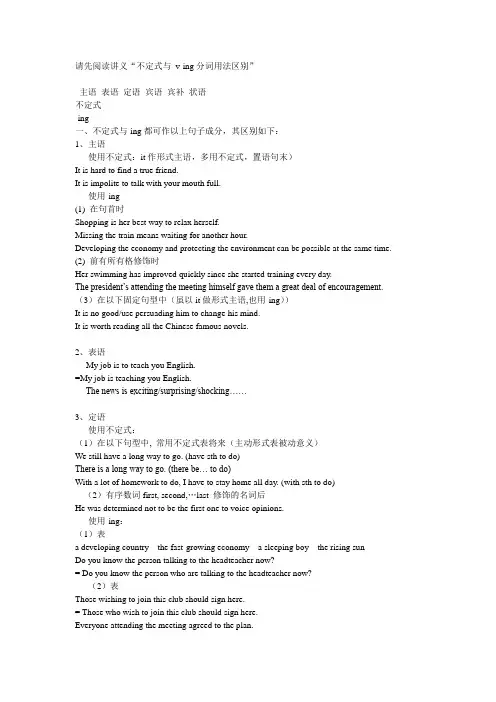
请先阅读讲义“不定式与v-ing分词用法区别”主语表语定语宾语宾补状语不定式-ing一、不定式与-ing都可作以上句子成分,其区别如下:1、主语使用不定式:it作形式主语,多用不定式,置语句末)It is hard to find a true friend.It is impolite to talk with your mouth full.使用-ing(1) 在句首时Shopping is her best way to relax herself.Missing the train means waiting for another hour.Developing the economy and protecting the environment can be possible at the same time.(2) 前有所有格修饰时Her swimming has improved quickly since she started training every day.The president’s attending the meeting himself gave them a great deal of encouragement.(3)在以下固定句型中(虽以it做形式主语,也用-ing))It is no good/use persuading him to change his mind.It is worth reading all the Chinese famous novels.2、表语My job is to teach you E nglish.=My job is teaching you English.The news is exciting/surprising/shocking……3、定语使用不定式:(1)在以下句型中, 常用不定式表将来(主动形式表被动意义)We still have a long way to go. (have sth to do)There is a long way to go. (there be… to do)With a lot of homework to do, I have to stay home all day. (with sth to do)(2)有序数词first, second,…last 修饰的名词后He was determined not to be the first one to voice opinions.使用-ing:(1)表____________a developing country the fast-growing economy a sleeping boy the rising sunDo you know the person talking to the headteacher now?= Do you know the person who are talking to the headteacher now?(2)表_____________Those wishing to join this club should sign here.= Those who wish to join this club should sign here.Everyone attending the meeting agreed to the plan.= Everyone who attended the meeting agreed to the plan.(3)表_____________an interesting story exciting news puzzling lights confusing rules disappointing results (4)表_____________a swimming pool a walking stick a writing desk a smoking area a changing room4、宾语使用不定式:在某些动词后He wishes to sleep at least for 8 hours every day.My father promised to buy me a cellphone if I got straight A in SA T.He pretended to be asleep when I approached her.后接不定式作宾语的动词还有:_______________________________________________________________________________ _______________________________________________________________________________ 使用-ing(1)在某些动词后He is considering changing for a new job.后接-ing作宾语的动词还有:_______________________________________________________________________________ _______________________________________________________________________________ (2)在介词后She relaxes herself by shopping。


动词不定式动词的非谓语形式有三种:不定式、动名词和分词一、动词不定式:动词不定式是动词的非谓语形式的一种,其形式是to + 动词原形,在句中可作除谓语以外的任何语法成分,即可作主语、宾语、定语、状语、表语和宾语补足语。
▲作主语:1. To obey law is everyone’s duty.遵守法律,人人有责。
2. To know oneself is difficult. 了解自己很难。
3. To do such things is foolish. 做这样的事是愚蠢的。
【注】在现代英语中,常用it作形式主语,把真正作主语的不定式短语放在后面。
4. It’s not easy to learn a foreign language well.要学好一门外语是不容易的。
5. It will not cost you anything to be polite. 礼貌待人并不会损失你什么。
6. It was impossible for him to explain what I meant. 要他把我的意思解释清楚是不可能的。
【注】在感叹句和疑问句中只能用it作形式主语。
例如:7. What harm can it do to give advice? 给人出主意有什么不好的?8. What fun it is to jump into a pool or lake in summer! 在夏天跳进游泳池或湖水里游泳是多么有趣啊!9. How long did it take you to finish the work? 你完成这项工作花了多少时间?▲在这种结构中,如果要表示不定式动作的执行者,要在不定式短语前加上一个for sb. 的短语,语法上称为不定式的复合结构。
例如:10. It is useful for you to learn some spoken English. 学一些英语口语对你来说是有用的。
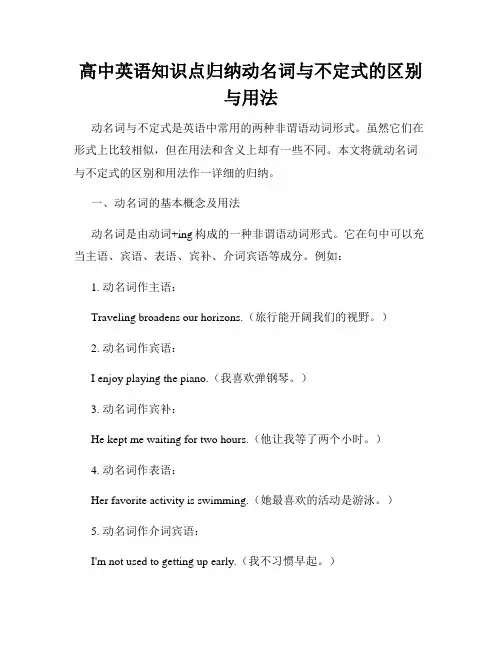
高中英语知识点归纳动名词与不定式的区别与用法动名词与不定式是英语中常用的两种非谓语动词形式。
虽然它们在形式上比较相似,但在用法和含义上却有一些不同。
本文将就动名词与不定式的区别和用法作一详细的归纳。
一、动名词的基本概念及用法动名词是由动词+ing构成的一种非谓语动词形式。
它在句中可以充当主语、宾语、表语、宾补、介词宾语等成分。
例如:1. 动名词作主语:Traveling broadens our horizons.(旅行能开阔我们的视野。
)2. 动名词作宾语:I enjoy playing the piano.(我喜欢弹钢琴。
)3. 动名词作宾补:He kept me waiting for two hours.(他让我等了两个小时。
)4. 动名词作表语:Her favorite activity is swimming.(她最喜欢的活动是游泳。
)5. 动名词作介词宾语:I'm not used to getting up early.(我不习惯早起。
)此外,动名词还可以与一些特定的动词搭配使用,如admit, appreciate, avoid, consider, delay, deny, enjoy, finish, mind, miss, practice, suggest等。
例如:I can't help laughing when I see his funny face.(当我看到他滑稽的表情时,我忍不住笑了。
)二、不定式的基本概念及用法不定式是由to+动词原形构成的非谓语动词形式。
它在句中可以充当主语、宾语、宾补、定语、状语等成分。
例如:1. 不定式作主语:To learn a foreign language is not easy.(学习一门外语并不容易。
)2. 不定式作宾语:I want to visit Paris someday.(我希望有一天能够访问巴黎。
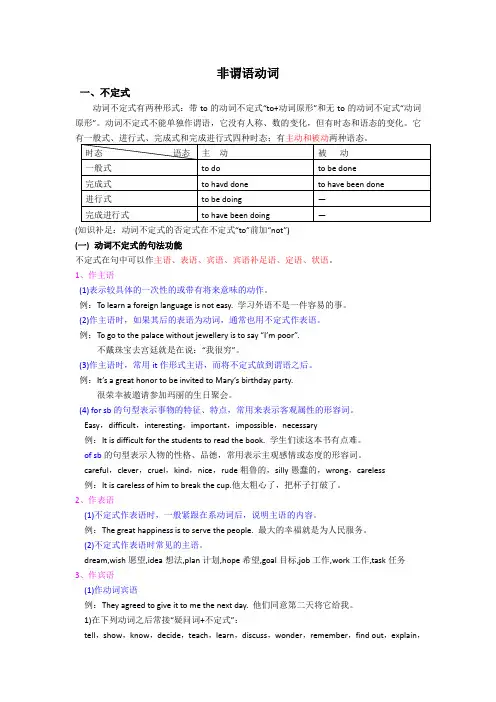
非谓语动词一、不定式动词不定式有两种形式:带to的动词不定式“to+动词原形”和无to的动词不定式“动词原形”。
动词不定式不能单独作谓语,它没有人称、数的变化,但有时态和语态的变化。
它(知识补足:动词不定式的否定式在不定式“to”前加“not”)(一)动词不定式的句法功能不定式在句中可以作主语、表语、宾语、宾语补足语、定语、状语。
1、作主语(1)表示较具体的一次性的或带有将来意味的动作。
例:To learn a foreign language is not easy. 学习外语不是一件容易的事。
(2)作主语时,如果其后的表语为动词,通常也用不定式作表语。
例:To go to the palace without jewellery is to say “I’m poor”.不戴珠宝去宫廷就是在说:“我很穷”。
(3)作主语时,常用it作形式主语,而将不定式放到谓语之后。
例:It’s a great honor to be invited to Mary’s birthday party.很荣幸被邀请参加玛丽的生日聚会。
(4) for sb的句型表示事物的特征、特点,常用来表示客观属性的形容词。
Easy,difficult,interesting,important,impossible,necessary例:It is difficult for the students to read the book. 学生们读这本书有点难。
of sb的句型表示人物的性格、品德,常用表示主观感情或态度的形容词。
careful,clever,cruel,kind,nice,rude粗鲁的,silly愚蠢的,wrong,careless例:It is careless of him to break the cup.他太粗心了,把杯子打破了。
2、作表语(1)不定式作表语时,一般紧跟在系动词后,说明主语的内容。
例:The great happiness is to serve the people. 最大的幸福就是为人民服务。
高考英语非谓语动词用法详解一、考点分析非谓语动词是语法填空的必考考点。
语法填空(常考:分词作宾补、定语、状语)翻译中也会有考点涉及。
不仅如此,掌握非谓语动词的基本用法,对增强书面表达的文采和提高阅读理解能力都有明显的作用。
二、专题详解(一)做主语1.动名词作主语的用法:1)动名词作主语往往表示经常性、习惯性的动作。
2)动名词作主语时,谓语动词用单数。
3)动名词作主语时,对于一些比较长的动名词短语,一般采用it 做形式主语,v-ing做真正主语注:it 做形式主语,v-ing做真正主语的常用句型是:It is no use crying over spilt milk. 覆水难收。
It’s a waste of time arguing about it.辩论这事是浪费时间There is no joking about such matters.这种事开不得玩笑。
There is no littering about. 不许乱扔杂物。
2.不定式作主语的用法:不定式做主语往往表示具体的特别是将来的动作。
如:It's no use crying over spilt milk.【抽象动作】He realized that to go on like this was wrong. 【具体动作】★★不定式和动名词均能作主语,二者有何区别?1.表示某一具体的动作时,多用不定式;表示比较抽象的一般行为倾向的,多用动名词。
2.动名词作主语时通常位于句首;不定式作主语时常置于句末,用it作形式主语放在句首。
1) Smoking is prohibited here. [抽象]2) It is not very good for you to smoke so much. [具体]Seeing is believing.To see is to believe.若主语和表语都是非谓语动词, 应保持形式上的一致。